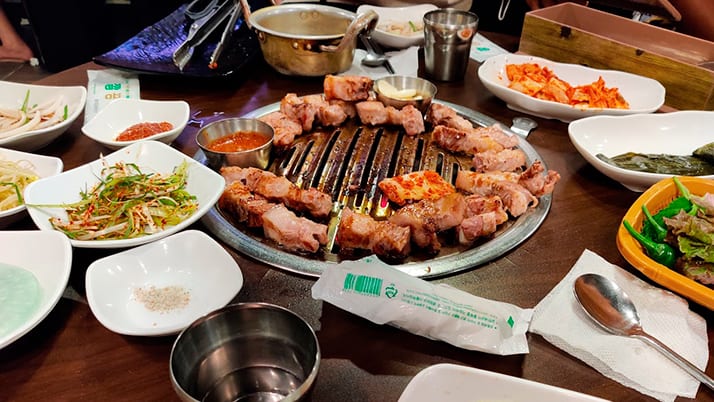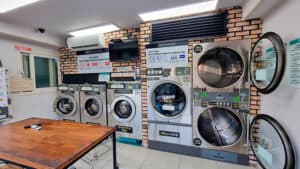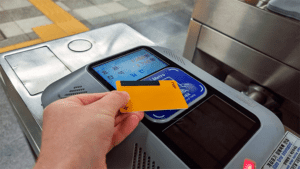How seating, ordering, and paying work in restaurants can vary greatly from country to country.
In this guide, I’m going to cover how everything regarding visiting different restaurants in South Korea works.
Recommended Read: Can You Visit South Korea Without Knowing Any Korean?
The short answer is that, generally, you enter the restaurant, tell the waiter or owner how many people you are, check out the menu, give your order to the waiter after indicating that you are ready to order, and then go to the counter when you are finished and ready to pay. You can find a more detailed answer below.
Table of contents
How does seating, ordering, and paying work in restaurants in South Korea
There is lots of food to experience in South Korea, so you’re going to find yourself at a restaurant quite often when visiting the country.
As restaurant formalities and culture vary across the world, it can be confusing at first how restaurants work in South Korea.
Though seating, ordering, and paying are done a bit differently based on the type of restaurant, I’m going to explain how each of the three aspects works in South Korea in general to the best of my ability as someone who’s visited the country for more than 6 months.
Seating
In many restaurants in South Korea, you wait at the entrance for someone to ask you how many people you are, after which they either bring you to a table or tell you that you can sit at any available table.
There are quite a few restaurants, however, where you do not have to wait to be seated. You simply walk in and sit down wherever there is an available table. These restaurants are usually smaller ones where the only employees or employee is at the back of the restaurant/kitchen at most times. In more formal restaurants, you always have to wait to be seated.
If you want to be safe, you can just wait at the entrance of any restaurant, and the employees at the back will tell you that you can just sit anywhere in case it’s a restaurant where you do not have to be seated.
Some restaurants that are very popular might not have any available tables at the moment, in which case they have a queue at the entrance you can put your name on if you wish to wait until there is available seating. Sometimes there is an employee taking your name for the queue, and other times it’s just a list. If there is an employee, you can ask them the approximate time till there’ll be an available table for you.
Restaurants that are extremely popular at the moment require you to have made a booking online to get a seat. However, most have seating available without booking.
Ordering
Once you’re seated in a restaurant, it’s time to check out the menu. In most restaurants, a menu is brought to you by a waiter, but at some, it’s already at the table, on the wall or counter, or readable by scanning a QR code at the table.
In case there is no English translation of the menu in a restaurant, you can use the Papago app to take a picture of it and translate the Korean writing into English.
Generally, the waiter will come and take your order. You can call upon the waiter by using the dedicated button on the table. If there is no button, you can either make eye contact and make a small hand gesture to let them know that you’re ready or say “jogiyo” (저기요), which is the ‘excuse me’ phrase used in a restaurant-type situation.
Recommended Read: How to Say Thank You in Korean
If you do not speak any Korean, you can simply point to whatever you wish to order on the menu and say the number of that item you want while making the hand gesture for that number. Then they will easily understand without you having to communicate much.
For those who want to try and order in Korean, you can use the simple phrase “igo juseyo” (이거 주세요), which means “give me this please”, while pointing to an item. You can also add a number, so there is no confusion as to how much of something you want, but that does require you to know numbers in Korean. Here is “give me one of this please” in Korean: “igo hana juseyo” (이거 하나 주세요).
The general phrase for ordering anything without pointing and saying this one is: “(food) (number) (juseyo)”. Depending on the type of item you are ordering, the number might be shortened and have an ending added, but they will most likely understand you even if you don’t have perfect grammar.
An example of this format for ordering a gimbab, for example, would be: “gimbab hana juseyo” (김밥 하나 주세요). An example of this format where the number is shortened and an ending is added could be ordering a cup of coffee: “kopi han-jan juseyo” (커피 한잔 주세요).
In some restaurants, the waiter does not come to your table to take your order. Instead, you go to the counter and order. Some faster-paced restaurants and fast-food locations also have a dedicated screen where you can place your order and then pick up the food at the counter once it’s done.
Paying
When you’re done with your meal in a restaurant and are ready to pay, you simply walk up to the counter or wherever the register is located in the restaurant.
The employee will then input what you’ve had, and you can then pay. In some restaurants, they give you the receipt when they bring the food to your table, in which case you should bring the receipt to the counter/register when you wish to pay.
You might sometimes have trouble paying with your card in South Korea, in which case you can pay with cash instead.
If you’re visiting a restaurant as a group, it’s possible to split the bill and pay one by one if you wish to. Just inform the employee that you wish to do so.
In restaurants where you order at the counter, you sometimes pay before getting and eating your food, and in restaurants where you order on a screen, you almost always pay beforehand.
There is no expectation of you to tip anything at restaurants. Some are even a bit confused by it. You can learn more in our guide on tipping in South Korea.
Additional things to know
Here are some additional things that are great to know when visiting restaurants in South Korea.
Some food in South Korea is cooked in front of you, like Korean BBQ. When the food is cooked in front of you, you sometimes have to cook it yourself, and other times an employee will come to do it for you. If you’re unsure whether or not you have to cook it yourself, wait a bit and see what happens. If no one comes and does it, you can start doing it yourself.
Water is free in most restaurants and on a self-serve basis, which means that you go and take a glass and fill it up at a water dispenser located somewhere in the restaurant.
If there already is a jug of water and glasses on the table when you arrive, you can sometimes grab a new jug of water somewhere in the restaurant yourself, but sometimes you have to ask a waiter for a new jug if you empty the one you had. The water from jugs is also free.
Besides a self-serve water area, some restaurants also have a self-serve food bar, where you can take additional side dishes for free if you finish the ones they give you.
Cutlery and napkins in most restaurants in South Korea are located in the drawer on the side of your table for you to take yourself.
Some traditional Korean restaurants have a no-shoes policy. If that’s the case, you’ll see an area at the entrance to store your shoes before entering the seating area, which is usually floor seating in these types of restaurants. In most restaurants in larger cities like Seoul and Busan, this is not the case, though.
Many restaurants have break times in the middle of their working day, which means they might be closed between certain hours of their regular business hours. You can see whether or not they have a break time on Naver or an app for finding restaurants like MangoPlate.
That’s everything you need to know about visiting restaurants in South Korea!
Have any input or suggestions for this guide? Let us know in the comment section below.




